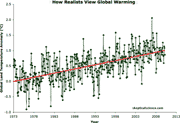Has the greenhouse effect been falsified?
What the science says...
| Select a level... |
 Basic
Basic
|
 Intermediate
Intermediate
| |||
|
The greenhouse effect is standard physics and confirmed by observations. |
|||||
Climate Myth...
Greenhouse effect has been falsified
"[T]he influence of so-called greenhouse gases on near-surface temperature - is not yet absolutely proven. In other words, there is as yet no incontrovertible proof either of the greenhouse effect, or its connection with alleged global warming.
This is no surprise, because in fact there is no such thing as the greenhouse effect: it is an impossibility. The statement that so-called greenhouse gases, especially CO2, contribute to near-surface atmospheric warming is in glaring contradiction to well-known physical laws relating to gas and vapour, as well as to general caloric theory.' (Heinz Thieme)
At a glance
Did you know that in the late 1700s, astronomers calculated the Earth-Sun distance to within 3% of the correct average value of 149.6 million kilometres? That was an incredible feat for the time, involving painstaking measurements and some pretty serious number crunching, with no help from computers.
Why is that mentioned here, you might ask. It's because not long afterwards, in the 1820s, French physicist Jean Joseph Baptiste Fourier made another crucial calculation. He worked out that at this distance from the Sun, Earth should have been an uninhabitable iceball.
Fourier suggested there must be some kind of insulating 'blanket' within the atmosphere. By the end of that century, Eunice Foote and John Tyndall had proved him quite correct through their experiments with various gases and Svante Arrhenius quantified matters in 1896, even calculating the effect of doubling the concentration of CO2. They had it largely figured out all that time ago.
If you are still sceptical about the existence of a greenhouse effect on Earth, there's something you can do in order to double-check. Go to the moon.
Well, you don't have to go personally, thanks to remote sensing and lunar landings by both unmanned and manned craft. Such intrepid expeditions mean we have a stack of data regarding lunar properties. The moon is pretty much the same distance from the Sun as Earth, but the lunar atmosphere is so thin it may as well not exist at all. There's virtually nothing to inhibit heat transfer, in or out.
In addition, the Moon turns but slowly on its axis compared to Earth. While a mean Solar day here lasts 24 hours, on the Moon it lasts just under a month. You get the best part of a fortnight of relentless Solar heating followed by a similar period of cooling in the long lunar night. So what's the temperature?
In the vicinity of the Lunar equator, daytime temperatures eventually reach a boiling hot 120oC. During the lunar night, that temperature drops away to -130° C. No atmosphere so no greenhouse effect. All that heat accumulated in the long lunar day just shoots straight back out into space. Nights on Earth may be much shorter, but nevertheless in the absence of a greenhouse effect they would be brutal.
Our approximately Earth-sized near neighbour, Venus, closer to the Sun, is different again. It has a massive dense atmosphere mostly consisting of CO2 with a side-helping of sulphur dioxide. Surface atmospheric pressure on Venus is so great that on Earth you would need to go a kilometre down in the ocean to find similar values. The planet rotates very slowly on its axis so days and nights are even longer than on the Moon. But unlike the Moon, Venus is always a hot place. Its surface temperature is over 450oC, day or night. An extreme greenhouse effect maintains that heat.
Remember: no atmosphere, no greenhouse effect and unimaginably cold lunar nights - but the example of Venus shows you can also have too much of a good thing. Earth really is a Goldilocks planet.
Please use this form to provide feedback about this new "At a glance" section. Read a more technical version below or dig deeper via the tabs above!
Further details
Some climate science deniers dispute the existence of the ‘greenhouse effect’. This is where their arguments lurch from silly - to beyond silly. The greenhouse effect keeps the surface temperature of Earth approximately 33oC warmer than it would be if there were no greenhouse gases in the atmosphere. In other words, without the greenhouse effect, Earth would be effectively uninhabitable.

Fig 1: The greenhouse effect is an analogy not meant as a scientific model of effect; hence, detractors have attacked the wrong model. (source: jg)
How do we know for sure this effect is real? The principle is demonstrated through basic physics, because a bare rock orbiting the Sun at the Earth-Sun distance (mean = 149.6 million kilometres) should be far colder than the Earth actually is. This was realised by Jean Joseph Baptiste Fourier in the 1820s, but the explanation why it was the case was not forthcoming for a few more decades. Fourier considered it to have something to do with the atmosphere having the properties of a kind of insulating blanket.
The existence of Fourier's hypothetical 'blanket' was confirmed by the experimental studies done by Eunice Foote and John Tyndall, working independently on either side of the Atlantic in the 1850s. Foote's results were announced at the 1856 meeting of the American Association for the Advancement of Science, and published in the American Journal of Science and Arts in the same year. The paper was entitled, ‘Circumstances Affecting the Heat of the Sun’s Rays’, with an excellent recent review by Ortiz and Jackon (2020). A key passage is as follows:
“The highest effect of the sun’s rays I have found to be in carbonic acid gas. An atmosphere of that gas would give to our earth a high temperature; and if as some suppose, at one period of its history, the air had mixed with it a larger proportion than at present, an increased temperature from its own action, as well as from increased weight, must have necessarily resulted.”
In his 1861 paper, “On the absorption and radiation of heat by gases and vapours, and on the physical connexion of radiation, absorption, and conduction” (PDF here), Tyndall stated:
“Now if, as the above experiments indicate, the chief influence be exercised by the aqueous vapour, every variation of this constituent must produce a change of climate. Similar remarks would apply to the carbonic acid diffused through the air; while an almost inappreciable admixture of any of the hydrocarbon vapours would produce great effects on the terrestrial rays and produce corresponding changes of climate.”
Tyndall had in his own words identified methane as an even more potent greenhouse gas than CO2. Later that century, Swedish scientist Svante Arrhenius put the numbers on the relationship between greenhouse gas concentrations and surface temperatures. He was able to calculate the effect of doubling the CO2 concentration in the air. The result was a globally-averaged figure of 5-6°C of warming, not that dissimilar to modern values.
Empirical Evidence for the Greenhouse Effect
We only have to look to our moon for evidence of what the Earth might be like, without an atmosphere and greenhouse effect. It's not as though we're short of data about our satellite. While the moon’s surface reaches 120oC (248oF) in direct sunlight at the equator during the long lunar day, when it gets dark the temperature drops down to a frigid -130oC (-202oF).
Since the moon is virtually the same distance from the sun as we are, it is reasonable to ask why at night the Earth doesn’t get as cold as the moon. The answer is that, unlike the Earth, the moon has no insulating blanket of greenhouse gases, because it has virtually no atmosphere at all. Without our protective atmosphere and its greenhouse effect, the Earth would be as barren as our lifeless moon. In the absence of the heat trapped overnight in the atmosphere (and in the ground and oceans) our nights would be so cold that few plants or animals could survive even a single one.
Conclusive evidence for the greenhouse effect – and the role CO2 plays – can also be seen in data from the surface and from satellites. By comparing the Sun’s heat reaching the Earth with the heat leaving it, both things we can measure with great accuracy, we can see that less long-wave radiation (heat) is leaving than arriving. Since the 1970s, less and less radiation is leaving the Earth, as the levels of CO2 and other greenhouse gases build up. Since all radiation is measured by its wavelength, we can see that the frequencies being trapped in the atmosphere are the same frequencies absorbed by greenhouse gases.
To conclude, disputing that the greenhouse effect is real is to attempt to discredit centuries of science, the laws of physics and indeed direct observation. Without the greenhouse effect, we would not even be here to argue about it.
Last updated on 26 November 2023 by John Mason. View Archives































 Arguments
Arguments

































Reed Coray @ 194
1. No. See Charlie Brown @ 189.
2. Not a fact. See #1.
3. Not a fact. See #1.
4. Yes.
5. No. See #1.
6. N/A. See #1.
Agreed – your arguments about trapping heat can be dismissed.
For further discussion – you say @195: “Those emissions may very well lead to increased global surface temperature. One thing I'm unsure about is "how big is the increase?". I say not “may” but “will.” The magnitude of the increase by increasing GHG emissions can be calculated with high accuracy. Also @ 182 you discuss ERE and conclude “to achieve a new ERE state when gases are added to the atmosphere, the temperature distribution within the system must change. One component of that temperature distribution is the Earth's surface temperature, which may go up or down.” When GHG are added to the atmosphere, the surface temperature will go up, not down.
Re-read the Basic and Intermediate explanations, then check out this tool to help you with the calculations and your question of “how big is the increase.” Hint: the results are consistent with the science of forcings as described in IPCC WG1 AR5 Physical Science Basis Chap 8 Table 8.2.
https://skepticalscience.com/Introducing-an-Atmospheric-Radiation-Model-to-Learn-About-Global-Warming.html
What's the difference between "atmosphere permanently and completely traps" and "atmosphere traps?" The definition of "trap" used as a verb is
1. Catch (an animal) in a trap. Synonyms: confine, cut off, corner, shut in, pen in, hem in, imprison, hold captive "a rat trapped in a barn“
a) Prevent (someone) from escaping from a place. “Twenty workers were trapped by flames” Synonyms: snare, entrap, ensnare, lay a trap for
b) Have (something, typically a part of the body) held tightly by something so that it cannot move or be freed. “He had trapped his finger in a spring-loaded hinge”
None of the above implies "permanently and completely" can't leave, they simply imply "can't leave." Good luck finding a non-technical dictionary that has a word that whose definition contains the words "permenantly and completely traps."
Ask a random person on the street if there is difference between "can't leave" and "permanently and completely can't leave." I think you're going to get a puzzled look.
In discussions of the greenhouse effect, most people do use "trap" in the sense you mean. But the average person rarely enters into a greenhouse effect discussion. So if you enter into a discussion of the geenhouse effect with the average person, he won't be aware of the subtle difference you imply. For example, if you pulled a coin out of your pocket and told the average person you have encased the coin in a substance that traps heat, I believe he's going to believe that heat can't leave the coin. He's not going to ask you "Do you mean permanently and completely not leave the coin" or simply "not leave the coin?"
When discussing something with the average person, assigning a meaning to a word that is deviates from the meanings commonly found in a generic dictionary is to confuse the person. If you told some one you've wrapped a coin in a substance that "permanently and completely traps the heat in the coin," what would you say if his response was: Do you mean "permanently and completely trap" or "really permanently and really completely trap?"
In technical discussions with people knowledgeable in the field it may be okay to use words that have a subtle meaning, but to use those words in the sense of the subtle meaning in conversations with lay people is to muddle the discussion. If you're trying to convince the average person that atmospheric greenhouse gases can trap heat and you don't qualify what you mean by trap with the caveat that "I don't mean "permenantly and completely", you're not communicating, you're obfuscating.
I think we've come to an impass. Regarding the meaning of "trapping heat," nothing I say will change your mind, and nothing you say will change mine. Stalemate. I'll leave the decision as to who is right to the public, but know that every time I hear someone make the claim that greenhouse gases trap heat, I'm going add: "he/she doesn't mean the heat is permenantly and completely trapped, he/she means the heat is temporarily trapped."
Reed Coray @ 202
In so doing, you would be spreading misinformation and you would be misrepresenting my explanation. I don't take kindly to that. It is not temporary, and as I have already explained, it is not inaccurate.
"So if you enter into a discussion of the geenhouse effect with the average person, he won't be aware of the subtle difference you imply. "
Specifically what "subtle difference" are you talking about? In talking about "adiabatic walls", it is you that is introducing the issue of permanence and completeness, not me, and not those explaining the greenhouse effect as "trapping heat".
I note you have not addressed the examples I gave. Is it reasonable in a discussion with a lay-person to talk of a blanket "trapping heat" or of a thermos flask "trapping heat"? Yes or no.
I have taken the time to directly answer your questions (although you have done nothing so far with those answers), so please give direct answers to mine.
"Regarding the meaning of "trapping heat," nothing I say will change your mind, and nothing you say will change mine. "
Speak for yourself. I am open to rational argument, such as a good answer to my question about blankets and thermos flasks "trapping heat", and willing to change my mind.
Reed Coray @ 202:
Well, at least you admit that you can't change your mind.
You have confirmed my statement, repeated in comment 199: " as I pointed out in #188, "...you create such a strict literal meaning to the words 'trap heat' that is unjustified."
FYI, we haven't changed our minds because you have not provided a convincing argument, and you keep avoiding questions that are asked.
You have presented one, and only one, definition of "trap", without citing a source. Most dictionaries provide several variations/definitions of "trap" suitable for different circumstances. Once again, you are cherry picking to suit your position.
Let's try another source for a definition of "trap": the Cambridge dictionary. It provides several definitions for "trap", one of which is:
Let's try the Collins Dictionary. One part of their definition says:
Of course, you will not find that convincing, because you probably believe that the Cambridge and Collins dictionaries are part of the Grand Plot to "manipulate truth and facts" in regard to human influences on climate.
...or maybe they just understand the colloquial use of "trap" better than you do.
Here is another one, from the Britannica dictionary:
Face it, Reed. Your argument is a dog that won't hunt.
Reed Coray,
Indeed, some people will try to argue that this matter of increased levels of ghgs causing an increase of the surface temperature is just a matter of opinion ... meaning there are no reasons why anyone would ‘have to’ change their belief.
That is an unscientific way to think about this matter which has a well-developed evidence-based understanding that is open to well-reasoned evidence-based improvements.
In addition to the comments by Others, especially Charlie Brown @201, I will specifically address your use of: may and unsure. I will also comment regarding 'permanent trapping' of heat energy.
Increased levels of ghgs ‘will’ (not may) increase the surface temperature. The current understanding is a range of potential magnitude of warming for a doubling of CO2 from 280 ppm to 560 ppm. But the low end of that ‘range’ is a significant increase. The only thing that is ‘unsure’ is how much worse than the very bad ‘best case’ the warming due to increasing CO2 levels ‘will’ be.
Note that the understood low end of the range of warming due to a doubling of CO2 levels is increasing, being (has been) updated ‘up’, because the current 50% increase of CO2, to 420 ppm from 280 ppm, has produced significantly more than a 1.0 C increase of surface temperature.
Building on the point of my comment @186, the increased ‘amount of trapped energy’ due to increased amounts of ghgs and the resulting increased average surface temperature is ‘essentially permanent’. It will last as long as the increased level of ghgs occurs. And increased CO2 levels will last a very long time, unless humans implement actions to effectively ‘essentially permanently remove’ CO2 from the atmosphere.
Hopefully, you were being hyperbolic when you declared that your mind was ‘permanently made-up regarding this matter’. The ability to learn is a critical thinking ability that enables humans to sustainably, permanently, improve things.